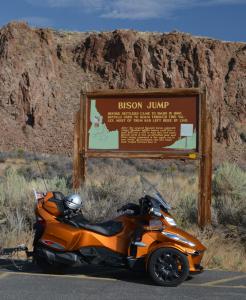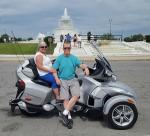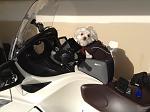|
-
Very Active Member


 Originally Posted by SteveandBelinda

How many miles do you think I have left, or should I go ahead and change? Stock tires on 2014 RTL, and 33,000
With that much tread left you sure someone didn't change the tires while you weren't looking?  Or do you ride only 40 mph on glass smooth concrete roads? I can't believe you have 33k miles on them with that much tread left. Or do you ride only 40 mph on glass smooth concrete roads? I can't believe you have 33k miles on them with that much tread left.

2014 Copper RTS
Tri-Axis bars, CB, BajaRon sway bar & shock adjusters, SpyderPop's Bumpskid, NBV peg brackets, LED headlights and modulator, Wolo trumpet air horns, trailer hitch, custom trailer harness, high mount turn signals, Custom Dynamics brake light, LED turn signal lights on mirrors, LED strip light for a dash light, garage door opener, LED lights in frunk, trunk, and saddlebags, RAM mounts and cradles for tablet (for GPS) and phone (for music), and Smooth Spyder belt tensioner.
-
Active Member


 Originally Posted by Easy Rider

The alignment of the front wheels will NOT change with different tires.
The rear, however, might change, as in probably will, and I would have it checked if the rear is replaced.
Rear was changed last week, alignment still on the spot.
2014 Can Am Spyder RT Limited - Pearl White
2010 Can Am Spyder RT - Full Moon 
-
Active Member


Wow, installed them today. Couldn't believe the differnce. Still running 19 psi, and may go a little lower, but 15 sounds a bit too low. Still rides smooth right now.
2014 Can Am Spyder RT Limited - Pearl White
2010 Can Am Spyder RT - Full Moon 
-
Ozzie Ozzie Ozzie


Next time you go on a reasonable ryde SteveandBelinda, check your tire pressures before you start ryding for the day & remember their pressures (or note them down somewhere), then after ryding for about an hour or so, stop & immediately check their pressures again & compare that 'hot' pressure with their cold start pressures - ideally, you should see a 4psi increase. If they haven't gone up by as much as 4psi, your cold start pressure was too HIGH, and they'd benefit (as would you) from dropping their cold starting pressure by about 2psi before you ryde next; and if they went up by more than 4psi, their cold start pressure was too low so you really need to add about half of the difference between what they actually are when hot & what they should have been if they had gone up by only 4psi, which in this instance with your cold start of 19psi, that'd be 23psi - so you'd want to add 1/2 of the pressure they actually reach when hot minus 23... say they reach 35psi (possible it was a cold morning and now it's a hot day) then 35 - 23 = 12 & 1/2 of 12 = 6, so you'd add 6psi NOW if you intend to continue ryding.
The further you are away from that 4psi increase after an hour's ryding, the more you are compromising some aspect of your tires ability to look after you & your ryde... which you can choose to knowingly do if you want, saaay, really responsive steering (that some might call twitchy) & the absolute best of fuel economy you can get by driving at 20mph everywhere except when coasting down hills over better tire life, better puncture resistance & better ryde & traction than when the tyres are rock hard then pump your tires up more or rock hard so that you get less than a 4psi increase when hot; or if you want traction & compliant steering/ryde over the ultimate in direct steering response (that twitchy feeling) & the best fuel economy thing then drop your tires a little more so you get a greater than 4psi increase, just don't go much below 14/15psi without carefully considering the compromises & risks you might be taking!
Do that on a few rydes of an hour or so & you'll pretty quickly get pretty close to setting the correct cold start pressure to mean you get very close to the optimal increase of 4psi after an hour's ryding which means your tires will be reaching their ideal operating temperature & you'll be getting the 'best' balance of ryde, noise, handling, traction, tread wear, hydroplaning resistance, dry &/or wet grip, puncture resistance, and tire longevity, etc, etc, etc. Yes, there will be some variation in the ideal cold start pressure depending upon your load, your particular ryding style today, the road surface, ambient temps, wet or dry roads etc, but despite any of those types of variables making some difference, it'll generally be a fairly small difference (largely cos your Spyders tires don't really hold a massive volume of air) and besides, if you are really concerned, you can check their pressures after an hour or so's ryding to see if you do need to add a bit of air or maybe let a touch of air out. 
Last edited by Peter Aawen; 04-25-2019 at 03:50 PM.
Reason: S&B's cold start pres of 19psi example
2013 RT Ltd Pearl White
Ryde More, Worry Less!
-
Very Active Member

-

 Originally Posted by Peter Aawen

, then after ryding for about an hour or so,
or maybe let a touch of air out. 
This is interesting and useful information but some comments might be in order:
Where I live, the ambient temperature when the sun is just coming up can be around 60 F and then 3 hours later it can be 90. And the temperature of the asphalt pavement can be much higher. So the conditions and time are rather important to get a good test.
A similar comment applies to letting air out.......which I think never should be done without going through a full 24 hour cycle.
Regardless of what the pressure IS after riding a while, if it goes back down to your "normal" cold value after sitting overnight, then it is NOT appropriate to be letting air OUT.
And this might be stating the obvious but these numbers won't apply to other types of vehicles.......although the theory is still valid.
-
Ozzie Ozzie Ozzie


 Originally Posted by Easy Rider

This is interesting and useful information but some comments might be in order:
Where I live, the ambient temperature when the sun is just coming up can be around 60 F and then 3 hours later it can be 90. And the temperature of the asphalt pavement can be much higher. So the conditions and time are rather important to get a good test.
A similar comment applies to letting air out.......which I think never should be done without going through a full 24 hour cycle.
Regardless of what the pressure IS after riding a while, if it goes back down to your "normal" cold value after sitting overnight, then it is NOT appropriate to be letting air OUT.
And this might be stating the obvious but these numbers won't apply to other types of vehicles.......although the theory is still valid.
Please ignore the comments I've quoted above, for the reasons I'll state below:
Regardless of the ambient & road temps when you check your tire pressures cold & what the ambient & road pressures may have reached when you check your tire pressures after ryding for an hour, if your tire pressure has risen by more than 4psi and you intend to continue ryding in the existing conditions, you need to add air to your tires as outlined in my post above. Now sure, if you KNOW you are ryding into a massive & freezing blizzard or any other significantly different conditions, then you might not want to add air pressure to inflate your tires to suit the conditions you've just been ryding in, but I'd hope that most would consider ryding into said blizzard might be a bit foolhardy & consider any forecast changes before they head on, and that they'd likewise consider expected changes if ryding on into any other significantly different conditions.
Re letting air out - if you've ridden for an hour and your tire pressures have not risen by 4psi, then your tire pressures are too high & you can safely let 'a touch' of air out now! Yes, I should have specified that by 'a touch' I'd normally mean saay 1psi, & generally never more than 2 psi - & for that I apologise, but I'd also expect that most could work out that if you started with 19psi & your tire pressures are now 26 psi then you'd not want to let more than a couple of psi out anyway - but please, if you know most people are running saaay 15 psi or so in their tires but the tire fitter who recently installed your new tires inflated those tires up to 40 or even 60 psi to seat the bead & then left that pressure in there (don't laugh, it happens!) even when the warning on the tire sidewall says something like Maximum pressure 35psi, and you've ridden for an hour on that 40 or 60psi (or whatever other stupidly high pressure might be in there) then please, let more than 1-2 psi out now. PLEASE! Only please do try to use the rough guide I provided & generally only let out 1/2 of the difference between what your tire pressure is now & what it should have been if your tire pressure only went up by 4psi - see my example in the earlier post. That will let you gradually step down closer to a safe pressure without leaving your tires under-inflated the next morning, and over time you should notice that your tires are gradually needing less & less changes up or down to achieve that 4psi increase from their cold start pressures, which means you are now running pressures that are much closer to the ideal pressure for YOU and for your tires & the way you ryde & load your Spyder on the roads and under the conditions you are generally ryding in!
Next comment, Please note that this 4psi figure & the 'rule of thumb' that I've outlined above can be used for any Passenger car 'P' type tire or any Light Truck 'LT' type tire that you might use on your Spyder, your passenger car or your light truck, van, or 4WD that's running 'J' or 'JJ' type safety rims just so long as it is running pneumatic tires made of a rubber &/or silica compound & they are inflated with compressed atmospheric air. There are some specific proviso's to make this 'rule' work for other types of tires, rims, vehicles, & gasses, but generally, pneumatic tires inflated with atmospheric air on Spyder, car, or light truck/4WD rims will all work pretty much the same way, and this method of determining what pressure to run in them is a handy way that almost anyone with a consistent air pressure gauge can use to fairly reliably get closer to their ideal pressure for their tires & ryding/driving. It's consistent, it's repeatable, and it considers any & all variables that might exist in the conditions or circumstances you ride/drive in/thru/under in the hour between checking your cold start pressures & reading the pressure an hour later, giving you a good guide about how those pressures can be used &/or adjusted to better suit the conditions & variables that you are now facing and expect to be ryding/driving into, thru, & under as you proceed.
And if you don't want to use this or any other method, I'm fine for you to make your own choices and do that, but I've posted this here in the hope that it might help some Spyder Ryders &/or vehicle drivers in their attempts to determine better tire pressures for the tires they've chosen to run on their ride or maybe even on their car, van, truck, or 4WD, rather than to draw nit picking comments from people who have little if any idea but just want to nit pick or argue...... 
2013 RT Ltd Pearl White
Ryde More, Worry Less!
-

 Originally Posted by Peter Aawen

Please ignore the comments I've quoted above, for the reasons I'll state below:
Maybe I should have said: Please ignore this man's advice.....because you could mis-interpret it and create a safety hazard.
But I didn't, instead trying to carry on an adult conversation and make some clarifications.
So.....who is it that is instead just creating an argument ??
P.S. Please ignore the part where he says that his theory applies to larger vehicles too.
The 4 psi change does NOT apply to large vehicles when the weather is HOT as those tires heat up MUCH more than 4 psi and that is perfectly normal.
-
Active Member


 Originally Posted by IdahoMtnSpyder

With that much tread left you sure someone didn't change the tires while you weren't looking?  Or do you ride only 40 mph on glass smooth concrete roads? I can't believe you have 33k miles on them with that much tread left.
Yep, bought the bike with 2600 miles, and never changed them. Live in Michigan, and have been to Quebec, Louisiana, South Dakota, Missoissouri, all over. Keep air at 19psi on front, and 28 in rear.
2014 Can Am Spyder RT Limited - Pearl White
2010 Can Am Spyder RT - Full Moon 
-
Active Member


Yes excellent tires I have on my 2014 RTS over 25000 miles they probably will 45 to to 50000 no problem
-
Ozzie Ozzie Ozzie


 Originally Posted by Easy Rider

......
The 4 psi change does NOT apply to large vehicles when the weather is HOT as those tires heat up MUCH more than 4 psi and that is perfectly normal.
Sorry ER, but that 4psi increase after an hour's driving does apply to any vehicle running on 'J' or 'JJ' type rims shod with Passenger car 'P' type tires or Light Truck 'LT' type tires that are pneumatic & inflated with atmospheric air, and this applies ESPECIALLY when the weather is hot - it's fairly simple, if your tires are increasing their pressure from cold much more than 4psi in just one hour of driving then their cold start pressure was too low so the sidewalls have been flexing more than ideal and they've heated up rapidly while the air inside increased temp & pressure too, so much so that the tire is at increased risk of catastrophic failure (ie, blow-out!) due to that initial under-inflation! An increase of MORE than 4psi or so means your tire is UNDER-INFLATED & not working for you as well as it could; while an increase of LESS than 4psi means your tire is OVER-INFLATED & not working for you as well as it could.
Many people get confused with this - tire pressures that are too LOW means the tire sidewalls flex a lot and so the tire carcass & the air inside it gets HOT quicker; while tire pressures that are too HIGH mean the tire sidewalls won't flex much at all so the carcass & the air inside it won't increase in temp or pressure anywhere near as quickly (altho the tread compound probably will, especially on the tiny ballooned out strip in the middle that's touching the road!) but you'll feel every bump & pebble on the road cos you're riding on rock hard tires & you risk tread delamination &/or puncture, just like popping an over-inflated balloon.  You need your tires to increase in temp & pressure just enough to activate the tread compound sufficiently to do its job properly but not so much that it wears rapidly or melts off; but if the temp & pressure increases by much more than that 4psi you will heading towards melting parts of your tires & tread that you really don't need or want to melt! And this applies especially so in hot weather for heavy vehicles that are already running at close to their tires load limits &/or maximum cold inflation pressures... not that we ever have either here in Aust! You need your tires to increase in temp & pressure just enough to activate the tread compound sufficiently to do its job properly but not so much that it wears rapidly or melts off; but if the temp & pressure increases by much more than that 4psi you will heading towards melting parts of your tires & tread that you really don't need or want to melt! And this applies especially so in hot weather for heavy vehicles that are already running at close to their tires load limits &/or maximum cold inflation pressures... not that we ever have either here in Aust! 
This 4psi thing is not just something I've pulled out of the air, it's been around for decades & forms at least part of the basis for all those charts of loads & recommended pressures & the tire placard figures on your car, van, 4WD, or bike etc and it is published in a variety of forms by many tire manufacturers too.
Last edited by Peter Aawen; 04-26-2019 at 03:00 AM.
2013 RT Ltd Pearl White
Ryde More, Worry Less!
-

Your information is valuable.
And your latest explanation is good.
Some of the generalizations in the first posts were not so good.
For instance, on a heavy duty vehicle with "semi truck tires" that start out at about 100 PSI when "cold", the pressure can rise as much as 15 PSI after running on hot pavement and that is perfectly normal. Like your 4 psi when starting out at 30 is 15%, so is the 15 psi when starting out at 100.
I think that suggesting to anyone in general that removing air from a HOT tire is a good thing to do is NOT a good suggestion........because they are not likely to remember the details when the time comes.......and every tire and vehicle maker in the world cautions AGAINST letting air out of tires when they are HOT.
Cheers.
-

 Originally Posted by Peter Aawen

This 4psi thing is not just something I've pulled out of the air, it's been around for decades & forms at least part of the basis for all those charts of loads & recommended pressures & the tire placard figures on your car, van, 4WD, or bike etc and it is published in a variety of forms by many tire manufacturers too.
Peter...
Thank you for the info. I am pretty anal regarding tires. I check my pressure on all vehicles in the early hours before the sun comes up. I don't have indoor storage for more than motorcycles. Once the sun hits any tire, that one gets warm fast. Check pressure at least monthly and before every trip or load change (up pressure in rear when hauling heavy load in pu truck). Ride feel, checking contact patch, and watching tread wear have been my only way of measuring proper fill. I'll try your advice and see what the results are.
Regards,
Don
-

 Originally Posted by SteveandBelinda

I currently have the stock tires that came with the bike (2014 RTL), and currently have 33,000 miles, which is excellent for the stock tires, but they are showing some wear
I got less than 5500 on my OEM fronts before they were in the wear bars. Gotta love those twisties!
Regards,
Don
 Posting Permissions
Posting Permissions
- You may not post new threads
- You may not post replies
- You may not post attachments
- You may not edit your posts
-
Forum Rules
|

